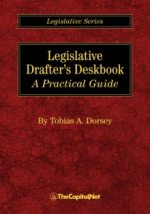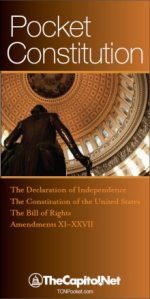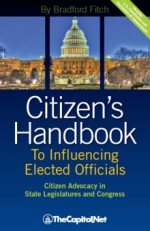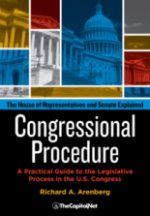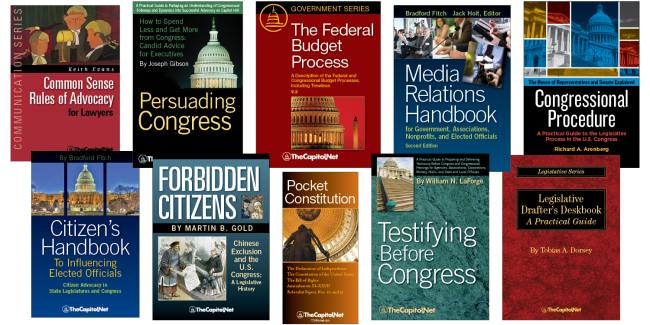From the Congressional Glossary – Including Legislative and Budget Terms
TCNLPF.com and LegislativeProcessFlowchart.com
Also see
|
The Legislative Process Flowchart is Copyright © by TheCapitol.Net.
This Flowchart is licensed under a Creative Commons Attribution-NoDerivs 3.0 Unported License. This means that you may use this flowchart in books, course manuals, handouts, presentations, and on the Internet with our permission as long as the flowchart is not altered, which includes displaying all headers, all URLs, copyright, and the Creative Commons license appearing on the flowchart. Permissions beyond the scope of this license may be available: www.thecapitol.net, 202-678-1600.
The Flowchart is available as a 1-page PDF ![]() .
.

How a Bill Becomes Law
I’m Just a Bill (Schoolhouse Rock!)
Introduction of Bills. Bills can begin in either the House or the Senate. Different versions of a bill can begin in both chambers concurrently.
- Bills can only be introduced by members of Congress.
- Many bills originate in the executive branch and are introduced by a congressional sponsor.
- New bills are numbered and sent to the appropriate committee.
Committee Action. The bill comes under its most intense scrutiny while in committee, and many bills die in committee.
- The bill is considered either by the full committee or a subcommittee.
- After hearings and study to "mark up" the bill, the full committee votes on a recommendation to the House or Senate.
- The committee may order a "clean bill," with a new number, to be introduced.
Floor Action. Next, the bill appears before the entire House or Senate. The two chambers have different procedures for floor debate.
House:
The House Rules Committee regulates debate for each bill, issuing the "rule" for the bill. Members can speak on a bill for a set period of time, as specified in the "rule." To speed debate on some bills, the House meets as the Committee of the Whole, which has different rules for floor debate. The Committee of the Whole can amend a bill, but cannot pass it. Senate: Senate debate is unlimited. Senators may speak at any length on any topic. Any senator can stop debate with a "filibuster." Debate can be closed by unanimous consent, or by invoking "cloture," which requires a three-fifths majority (at least 60 votes) of the entire Senate. Second Chamber. Once one chamber has voted to pass a bill, the other chamber may:
- Pass it with the language intact.
- Refer it to a committee for scrutiny or alteration.
- Reject the entire bill, informing the other chamber of its actions, or
- Ignore the bill, while continuing to work on its own version of the legislation.
Conference. When the two chambers pass differing versions of legislation, the bill goes to conference – the "third chamber" of Congress.
- Conferees for the House and Senate committees that worked on the bill meet together to work out a compromise.
- Conferees are not allowed to write new legislation; they must work within the boundaries of the differences in the House and Senate bills.
- When the conferees have reached agreement, they submit a report of their recommendations to each chamber for approval.
The President. The Speaker of the House and the President of the Senate both sign the approved bill and send it to the president, who then has four options.
- If the president signs and dates the bill, it becomes law.
- If Congress is in session, and the president does not sign the bill within 10 days, the bill becomes law without his signature.
- The president may "veto" the entire bill. The bill goes back to Congress for a second vote, in which it must get a two-thirds majority of votes in each chamber in order to become law.
- If Congress adjourns within 10 days of giving the bill to the president, and he does not sign it, the bill dies. This is called a "pocket veto."
See also
- Bills / Measure / Passed (CongressionalGlossary.com)
- Concurrent Resolution (CongressionalGlossary.com)
- Joint Resolution (CongressionalGlossary.com)
- Private Calendar / Private Bill (CongressionalGlossary.com)
- Law / Public Law / Private Law (CongressionalGlossary.com)
- Slip Laws (CongressionalGlossary.com)
- Terms and Sessions of Congress
More
- Congressional Procedure, Chapter 2. Introduction of Legislation
- “Bills and Resolutions: Examples of How Each Kind Is Used,” CRS Report 98-706 (6-page PDF
 )
) - Private Bill – Wikipedia
- “Private Immigration Legislation,” CRS Report RL33024 (37-page PDF
 )
) - “Procedural Analysis of Private Laws Enacted: 1986-2013,” CRS Report RS22450 (12-page PDF
 )
) - “Private Bills: Procedure in the House,” CRS Report 98-628 (3-page PDF
 )
) - “The Legislative Process on the House Floor: An Introduction,” CRS Report 95-563 (18-page PDF
 )
) - “Introducing a House Bill or Resolution,” CRS Report R44001 (13-page PDF
 )
) - “The Legislative Process on the Senate Floor: An Introduction,” CRS Report 96-548 (20-page PDF
 )
) - “The Basics of Committee Markups,” Parliamentary Boot Camp (4-page PDF
 )
) - “Budget Process and Enforcement,” Parliamentary Boot Camp (4-page PDF
 )
) - “Committee Hearings,” Parliamentary Boot Camp (2-page PDF
 )
) - “The Committee on Rules & Special Rules,” Parliamentary Boot Camp (4-page PDF
 )
) - “Drafting and Offering Amendments,” Parliamentary Boot Camp (4-page PDF
 )
) - “The Germaneness Rule,” Parliamentary Boot Camp (2-page PDF
 )
) - “The House Calendar, Journal, and Record,” Parliamentary Boot Camp (2-page PDF
 )
) - “House Floor Basics,” Parliamentary Boot Camp (4-page PDF
 )
) - “Open Rules and Appropriations Bills,” Parliamentary Boot Camp (4-page PDF
 )
) - “Resolving House-Senate Differences,” Parliamentary Boot Camp (4-page PDF
 )
) - “Senate Procedure From a House Perspective,” Parliamentary Boot Camp (4-page PDF
 )
) - “From Slip Law to United States Code: A Guide to Federal Statutes for Congressional Staff,” CRS Report R45190 (17-page PDF
 )
) - “House Rules Changes Affecting Floor Proceedings in the 117th Congress (2021-2022),” CRS Report R46790 (11-page PDF
 )
)
Courses
- Congressional Operations Briefing – Capitol Hill Workshop
- Drafting Federal Legislation and Amendments
- Writing for Government and Business: Critical Thinking and Writing
- Custom Training
- Drafting Effective Federal Legislation and Amendments in a Nutshell, Audio Course on CD
- Congress, the Legislative Process, and the Fundamentals of Lawmaking Series, a Nine-Course series on CD
Publications
CongressionalGlossary.com, from TheCapitol.Net
For more than 40 years, TheCapitol.Net and its predecessor, Congressional Quarterly Executive Conferences, have been teaching professionals from government, military, business, and NGOs about the dynamics and operations of the legislative and executive branches and how to work with them.
Our custom on-site and online training, publications, and audio courses include congressional operations, legislative and budget process, communication and advocacy, media and public relations, testifying before Congress, research skills, legislative drafting, critical thinking and writing, and more.
TheCapitol.Net is on the GSA Schedule, MAS, for custom on-site and online training. GSA Contract GS02F0192X
TheCapitol.Net is now owned by the Sunwater Institute.
Teaching how Washington and Congress work ™

